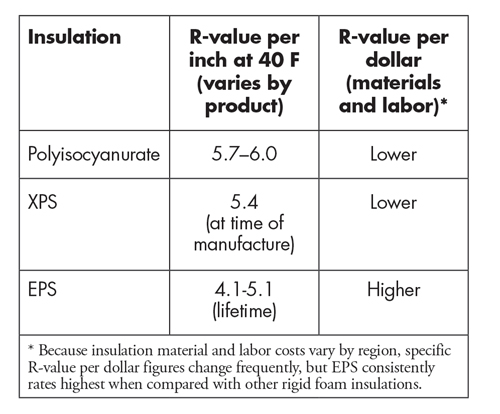Editor's note: The opinions in this article are those of the author and not NRCA.
Cost is the most important factor when a building owner chooses a roof system for a commercial building, according to a 2014 survey of building owners conducted by Buildings magazine for the EPDM Roofing Association. According to the study, 39 percent of building owners cited cost as their top roofing consideration. Product warranty and long-lasting components also were highly rated just behind cost, indicating building owners and roofing professionals want to balance performance and cost.
Choosing the proper insulation is one way roofing contractors can build performance into their roof systems while not breaking their customers' budgets.
Cost-benefit metrics
When it comes to installing insulation, professional roofing contractors have several workable choices. However, as with other roof system components, the benefits versus costs of different insulation materials vary. Among the primary rigid foams—expanded polystyrene (EPS), extruded polystyrene (XPS) and polyisocyanurate—which material offers the best bang for your insulation buck?
Until recently, many building professionals tried to answer this question by comparing the R-value per inch of various insulation materials with higher R-value figures deemed better. Savvy roofing contractors and product specifiers recognize the goal is not to fit as much insulation as possible into the roof assembly but rather to optimize the insulation by choosing a product that balances upfront costs with the energy savings offered during a roof assembly's life. For cost versus benefit, a more helpful rating is the R-value per dollar spent on materials and labor.
The figure on page 46 compares these two measures for common rigid foam insulations. The difference in R-value per dollar between EPS and polyisocyanurate became more pronounced in spring 2014 when several insulation manufacturers announced polyisocyanurate insulation price increases of 5 percent to 7 percent.
Thermal performance
2014 marks an important change in how rigid foam insulation thermal performance is evaluated. New test methods effective Jan. 1 reduced the long-term thermal resistance of polyisocyanurate insulation by about 6 percent. The result is roofing contractors will need to install greater thicknesses of polyisocyanurate insulation to obtain the same R-values as before.
Likewise, when evaluating XPS and EPS insulation, it is equally important to consider their long-term R-values. Several studies, such as the EPS Industry Alliance's "15-Year In-Situ Research Shows EPS Outperforms XPS in R-Value Retention," have shown XPS loses significant R-value in the field. By comparison, EPS does not have blowing agents that diffuse over time, so its R-values remain stable. Roofing contractors easily can see this difference when comparing insulation warranties—EPS manufacturers warrant 100 percent of their products' R-values while XPS manufacturers do not.
It also is worth noting EPS insulation is available in much greater thicknesses than XPS or polyisocyanurate insulation. This allows roofing contractors to achieve higher R-values with fewer EPS layers, reducing labor time and cost.
Money-saving tips
In light of cost ranking as the highest factor in roof system selection, roofing contractors are looking for ways to reduce insulation labor and material costs. To this end, EPS provides several ways to save money while still contributing to a well-insulated roof.

A comparison of insulation types and R-values
Following are five roofing applications in which EPS can help save money over using other rigid foam insulations:
EPS can be used in almost all roofing applications that use other rigid insulations. However, roofing professionals should note EPS cannot be used in direct contact with solvent-based adhesives. Such applications must use composite or faced EPS products that are designed specifically for adhered systems, as well as systems that use solvent-based adhesives.
ASTM International standards
Regardless of the rigid foam insulation type used, roofing contractors should check the specified product meets the appropriate ASTM International standards:
Many insulation materials currently on the market do not meet these standards, resulting in undesirable moisture retention, subpar thermal performance or other shortcomings that cost the building owner money, thereby reflecting poorly on the roofing professional.
Roofing contractors who choose EPS insulation for their roofing projects can rest assured the material has performed well in installations throughout North America and is recognized as code-compliant.
Don't break the bank
EPS insulation is code-compliant, won't break a building owner's budget and saves installation time and labor. For roofing contractors looking for a way to balance roof system performance with cost, including EPS insulation in a roof system's design is a viable option.
Ram Mayilvahanan is product marketing manager for Insulfoam, a Carlisle company, Carlisle, Pa.
COMMENTS
Be the first to comment. Please log in to leave a comment.